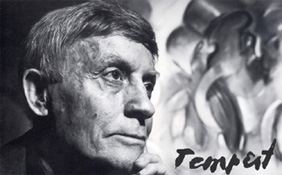|
|

A CONVERSATION WITH GERARD TEMPEST
Michael Taylor
Associate Curator 20 Century Art, Philadelphia Museum of Art, 2002
Gerard Francis Tempesta was born in the
town of San Donato Val di Comino, east of Rome, on February 23, 1918. In 1929
the family moved to Quincy, Massachusetts, later changing their name from
Tempesta to Tempest. Following his service in the U.S. Army during World War
II, when he took part in the D-Day landings in Normandy, Tempest moved back to
Massachusetts to study at the Boston Museum School at Tufts University from 1945
to 1948, under the guidance of Max Beckmann and Oscar Kokoschka. In 1948 the
artist moved to Rome with his wife, Sarah Margaret Cameron, in order to continue
his studies at the Accademia di Belle Arti under the G.I. Bill. During his time
in the Italian capital, he studied with Giorgio de Chirico, who was favorably
impressed by his painting skills and his knowledge of art history. Tempest
would spend two years in de Chirico's studio, working side by side with him.
The two men shared a passion for the techniques of painting and for horses, a
favorite subject of the Florentine Mannerist artists Antonio Tempesta
(1555-1630), an ancestor of Gerard Tempest whose prints of battle scenes de
Chirico admired greatly.
The time the two artists spent together in de Chirico's studio sewed the seeds
of a lifelong friendship. In 1949, at his mentor's suggestion, Tempest returned
to the United States to study philosophy, which de Chirico considered to be
crucial for a painter to grasp. Following the completion of his degree in
philosophy at the University of North Carolina, Chapel Hill, Tempest went on to
study architecture at Harvard University and later designed the acclaimed Villa
Tempesta in Chapel Hill, whose spatial complexity and unexpected vistas recall
the buildings found in de Chirico's metaphysical paintings. Over the years
Tempest was a frequent visitor to de Chirico's home and studio and throughout
his long career as a portrait painter and abstract artist (he calls his work
abstract spiritualism), the training he received under de Chirico continued to
inform his work. Despite de Chirico's resistance to abstract art in his later
years, he always enthusiastically supported his former pupil's work, writing
catalogue introductions and critical reviews of the exhibitions that Tempest had
in Italy. In 1972 Tempest returned the favor by helping to organize de
Chirico's retrospective at the New York Culture Center, which included more
than 180 paintings, sculptures, and works on paper. This exhibition introduced
de Chirico's post-Metaphysical work to an American audience for the first time
leading to a critical reevaluation of his achievement.
* This is an excerpt of an extensive interview
published in the catalogue Georgio de Chirico and the
Myth of Ariadne, Philadelphia Museum of Art, 2002.
|
|
|